To Tweet, Or Not To Tweet: This Will Answer Your Questions
Brent Sackris
Oprah's doing it. Ashton's doing it. Heck, by now, the birds and the bees are probably doing it too, but even in the midst of this 2009 Twittering Tornado that has led Twitter to become the new social networking Wunderkind in the U.S., many people still have some basic questions about what all the fuss is about. And as a teacher, you may have even less impetus to dive in and sign up to a social networking site that gives you updates about the whereabouts of Jessica Simpson's prized pooch.
However, with a teacher's perspective in mind, this article will give you the ins and outs of signing up for Twitter, and some specific guidelines about what it can do for you as well as what not to do with it. Hopefully, after reading this article, you'll be able to create a twitter page that will surely give your student-followers something to re-'Tweet' about.
So, what exactly is Twitter?
Twitter is a real-time short messaging service (SMS) that works over multiple networks and devices (for purposes of this article, we will stick to just talking about Tweeting from the Twitter website). By using 140 characters or less, people from all around the world can log into Twitter's website and update their "What are you doing?" box (shown below) to share anything relevant to them with the rest of the world —from breaking news to updates from friends -- the "What are you doing?" box becomes your personal beacon between yourself and the world, and it keeps track of how many characters you have left to use as you type (spaces included).
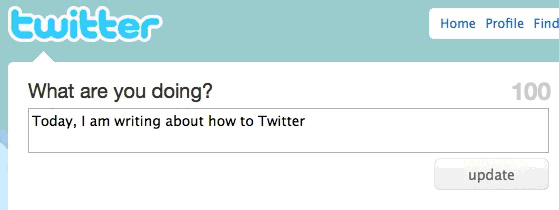
So, why do I need to Twitter if I have Facebook?
One of the most commonly asked questions, especially considering that both Twitter and Facebook seem to always want to know "What are you doing?" However, although many people might send the same "status update" to both Twitter and Facebook, the two websites' similarities end there.
Facebook's primary purpose is to reconnect people with old friends and family members or find new friends online; in fact, based on the information you enter into your Facebook profile, Facebook will recommend people it thinks you should know. Facebook also functions like an online journal/photo-album as each Facebook user can upload photos, videos, and stories about their lives and then decide who from their Facebook friends list they would like to share these stories with. In most cases, both the creator of the online Facebook content and the viewer of said created content need to be 'Friends' on Facebook before either one can see what the other is doing. Facebook also has its own instant messaging and mail service that can be used while he/she is logged into the site to further communicate with their friends on Facebook, and, consequently, 'hang-out' on the Facebook site.
Twitter, conversely, does not require you to set up much of a profile at all (in fact, it limits the length of your twitter screen name, and your twitter profile is limited to one picture and one 160 character byline). Twitter exists as a jumping off point to get your ideas (or location) out onto the Internet as quickly as possible, and in my opinion, works best when used as a springboard to provoke further discussion. Also, unlike Facebook, you don't need to be a mutual friend of someone to see what they are up to (and viceversa), but conversely, no one on Twitter will now what you are doing if they are not following you.
So How Should I Sign Up If I'm A Teacher?
Like all social networks it is best to keep your professional and private online life separate, and Twitter is no exception. So when signing up for Twitter, especially if you will be communicating with students, DO NOT ALLOW TWITTER TO AUTOMATICALLY FIND PEOPLE FROM YOUR CURRENT EMAIL CONTACTS. After filling out the initial information and choosing your Twitter screen name, be sure to SKIP THIS STEP shown in the image below by clicking on 'Skip this step' at the bottom of that screen.
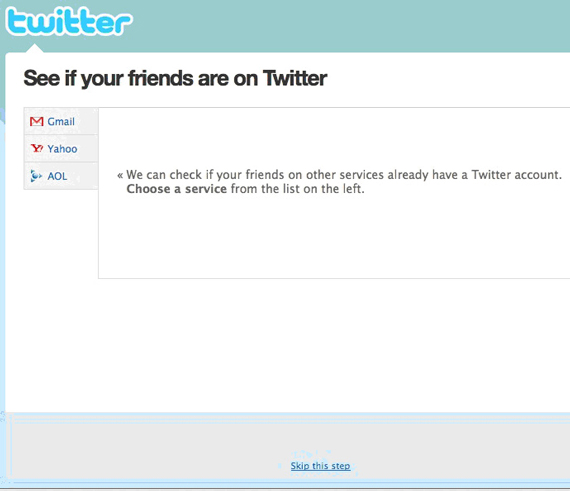
Twitter will then entice you to start 'Following' famous (or infamous) fellow Twitterers as shown in the screen below. Again, if you'll be using this to communicate with students, I suggest you just skip this step as well (and go back at a later date to select 'school worthy' people/sites worth following).
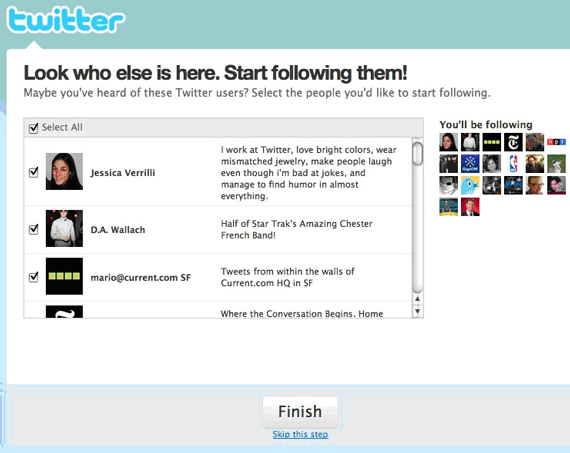
So if everything went correctly, your screen should look like the one below (minus the RED TEXT help text).
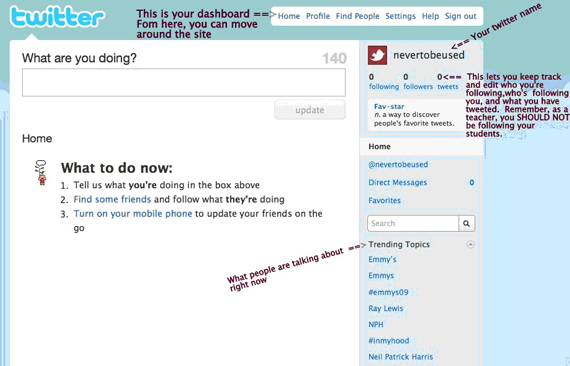
To Lead or To Follow
The way people stay in touch on Twitter is by following others and collecting followers. Once you decide to follow someone, all their updates will appear on your page (which anyone else can then see when they look at your Twitter web page). However, if you do not care about who you follow, you could wind up with a professional Twitter page that looks something like the image below, especially if you allowed twitter to automatically grab the email addresses during the initial sign-up, and you have communicated with some of your students in the past.

Instead of automatically following people from your email, if you are using Twitter as a means to communicate with students, give your students your Twitter name and have them follow you. This way, they can stay in touch with you when they are in your classes, and they can stop following you when they are not. If you are not following anyone, no Tweets but your own will appear on your page for the world to see, and unlike Facebook, you don't have to worry about someone posting an inappropriate comment to a topic you've posted.
So now that I've got the basics, what should I tweet about?
Honestly, there is no one right thing to tweet about, but from a classroom teacher's perspective, here's a list of things you could use your Twitter for:
- Use it as another way to post homework assignments.
- Post homework problems or extra credit problems.
- Post fun facts about people students are studying.
- Post changes to a class schedule or a school closing.
- Supplement your classroom readings by Tweeting Related Articles (You can Use 'Tiny it' to shorten the web links--see previous Teacher's Network How To article if you don't already know how to'Tiny it')
So, perhaps your twitter page might look like the one below:
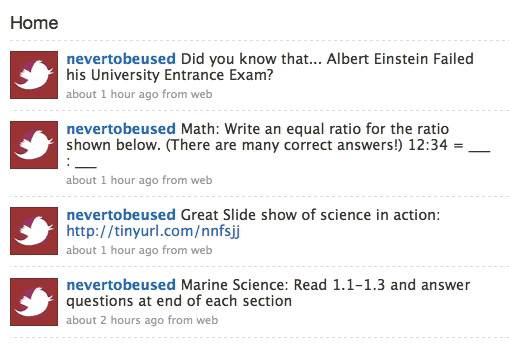
Ok, so anything as a teacher I shouldn't tweet about?
- Again, this list is not all-inclusive, but here are somethings that as a teacher you should definitely NOT be putting up on your twitter page:
- Any information about your personal life
- Any tweets from anyone in your personal life
- Any personal information about students
- Any links to questionable website material
So, is brevity really the mark of 'Twit'?
Just remember, newbie-tweeter, it's 'Tweet,' and never 'Twit,' and you've just gotten a bare-bones introduction to some of the suggested uses (and suggested cautions) about using Twitter as a teacher.
I encourage you to open up a personal Twitter account so that you can follow other teachers and educators that have great suggestions of not only ways to use Twitter, but ways to incorporate other technology into the classroom (as well as links and discussions to lesson plans, policy discussions, etc). While using your personal account, you can also explore some of Twitter's other features without any worry of inadvertently broadcasting the wrong things to your students.
But in the meantime, you now have a way to have a safe, one-way conversation with your students about the things that matter most for their classes.
And who knows... type something cool enough, and your students may even re-'Tweet' your tweet, possibly spreading your knowledge as an educator into the far corners of the earth (or at the very least, giving that kid that takes a daily snooze in your 7th period Calculus class a second chance to wake up and smell the polynomials).
Do you have a question about this article? E-mail Brent Sackris.
|